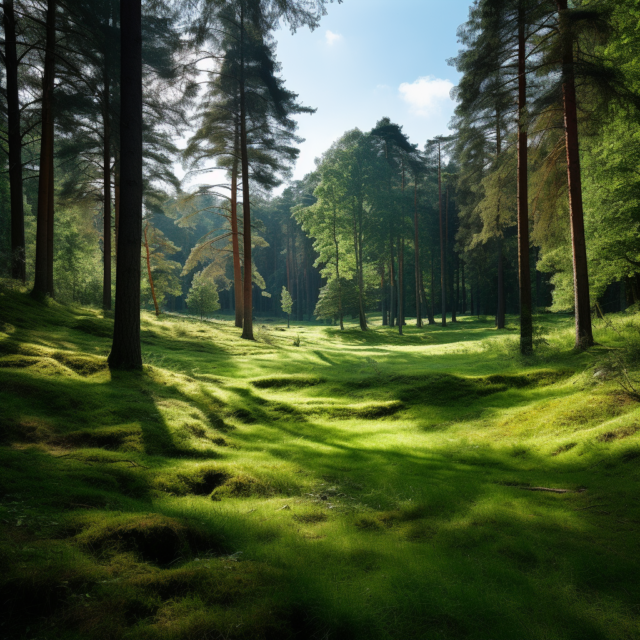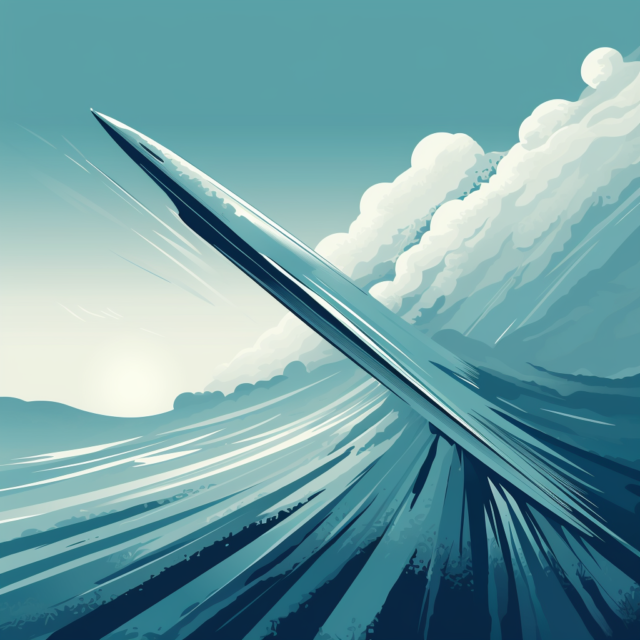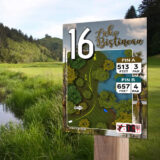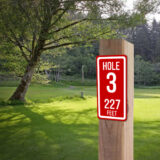Exciting changes are underway at Hinkey Park in California as it undergoes a transformation, including a name change to Ancient Oaks, a nod to the majestic and sprawling oak trees that grace the property. This rebranding captures the essence of the park’s natural beauty and establishes a connection to the land’s rich history. The Ancient Oaks Disc Golf Course promises players a unique experience as they navigate through the challenging terrain, with the imposing oaks providing both obstacles and breathtaking scenery. The course’s redesign showcases a thoughtful blend of modern disc golf dynamics and a reverence for the ancient oaks, making Ancient Oaks an inviting destination for players seeking a harmonious blend of nature and sport.
Post Page | Custom Disc Golf Tee Signs | Course Maps
Embark on a disc golf journey at Wickham Woods Disc Golf Course, where the innovative dual tee signs, featuring long blues and short whites, offer a strategic twist to the playing experience. The long blues provide a challenging layout for seasoned players seeking precision, while the short whites offer a more relaxed option for beginners or those looking for a laid-back round. This thoughtful design ensures inclusivity, allowing individuals to adapt the course to their skill level. Navigating Wickham Woods becomes a tactical adventure, with each player choosing their preferred tee to tailor the game to their unique style. With its dual tee sign setup, Wickham Woods stands as a welcoming destination for disc golf enthusiasts, providing a dynamic and enjoyable playing environment for players of all levels.
Discover a distinctive disc golf experience in the heart of Florida, where modern gameplay converges with a touch of timeless charm. The course’s tee signs stand out with vibrant colors and bold typography, creating a visually striking atmosphere that goes beyond the ordinary. As players approach each tee box, they are greeted by these captivating signs, setting the stage for a round filled with excitement. The course overview sign, strategically placed near the entrance, provides a comprehensive view of the entire layout against a backdrop of palm trees and sunsets, enhancing the overall atmosphere. This fusion of contemporary disc golf and unique aesthetics transforms each throw into a memorable journey, making the Florida disc golf course a must-visit for players of all skill levels.
Nestled along the tranquil shores of Toledo Bend Reservoir in Louisiana, North Toledo Bend State Park beckons disc golf enthusiasts with its lush landscapes and diverse ecosystems. As players traverse the disc golf courses, they encounter a unique challenge – navigating throws around the various pine tree species that grace the park. In this blog post, we’ll delve into the fascinating world of Longleaf, Loblolly, Shortleaf, and Slash Pines, exploring how these majestic trees enhance the disc golf experience while posing a formidable challenge for players.
- Longleaf Pine (Pinus palustris):
Standing tall and commanding attention, the Longleaf Pine dominates certain sections of the disc golf courses at North Toledo Bend State Park. With their long, slender needles and towering presence, these pines create both an aesthetic and navigational challenge for disc golfers. Players must strategize their throws to avoid these majestic trees, adding an extra layer of complexity to the game.
- Loblolly Pine (Pinus taeda):
The Loblolly Pine, characterized by its straight trunk and distinctive bark, often lines fairways and defines course boundaries. Disc golfers must carefully plan their shots to navigate through the gaps between these imposing trees. The Loblolly Pines contribute to the strategic layout of the course, demanding precision and skill from players aiming to master the game.
- Shortleaf Pine (Pinus echinata):
Scattered throughout the disc golf courses, the Shortleaf Pine presents a challenge with its shorter needles and dense canopy. Players find themselves faced with strategic decisions as they weave their throws through these pines. The Shortleaf Pines not only contribute to the visual appeal of the course but also demand a thoughtful approach from disc golfers aiming for a successful round.
- Slash Pine (Pinus elliottii):
Along the edges of the courses and near water features, the elegant Slash Pine adds an extra layer of difficulty for players. The drooping branches and slender needles create obstacles that require precision and finesse. Disc golfers must navigate their throws skillfully to avoid the gracefully imposing Slash Pines, turning each hole into a strategic puzzle.
North Toledo Bend State Park’s disc golf courses offer not only a thrilling outdoor experience but also a unique encounter with the diverse pine tree species that characterize the region. Longleaf, Loblolly, Shortleaf, and Slash Pines create a natural obstacle course, challenging players to adapt their strategies and techniques. As disc golfers aim for that perfect throw, they also gain a deeper appreciation for the delicate balance between nature and recreation in this picturesque corner of Louisiana. So, grab your discs, embrace the challenge, and immerse yourself in the beauty of disc golf amidst the pines at North Toledo Bend State Park.
The Scorpion stands as the second course within The Hideaway Disc Golf Ranch, an enchanting 18-hole woodland course cradled in the arms of nature. Enhanced by trees and varying elevations, it introduces an added layer of thrill and strategic complexity to your game. The course boasts turf tee pads, offering a sturdy launchpad for a consistently gratifying experience. The presence of MVP Black Hole Portal baskets, equipped with a 36-gauge galvanized steel chain assembly, ensures a professional touch.
More than just a course, “The Scorpion” presents an adventure that beckons you to hone your skills, immerse yourself in the wilderness, and relish the gratification of mastering the intricacies of wooded disc golf. Remarkably, this experience unfolds within a convenient 45-mile radius of downtown Dallas.
Landry Vineyards was established in 1999 in Folsom, Louisiana by Jeff, Libby, and their four sons: Ethan, Kohen, Noah, and Micah along with the loving labor of family and friends. The first grape vines planted were two acres of a French-American hybrid wine grape, Blanc Du Bois. Landry Vineyards was licensed as a Louisiana Native Winery in 2002. Soon after the devastation of Hurricane Katrina, the Landry’s used the storm opportunity to relocate to north Louisiana where soil, hills and climate are more suitable to growing wine grapes. They now reside in the beautiful hill country of West Monroe, Louisiana on a 52-acre site with a new winery, vineyards, beautiful tasting room, cottages, and camper sites, as well as live music events in the Spring and Fall.
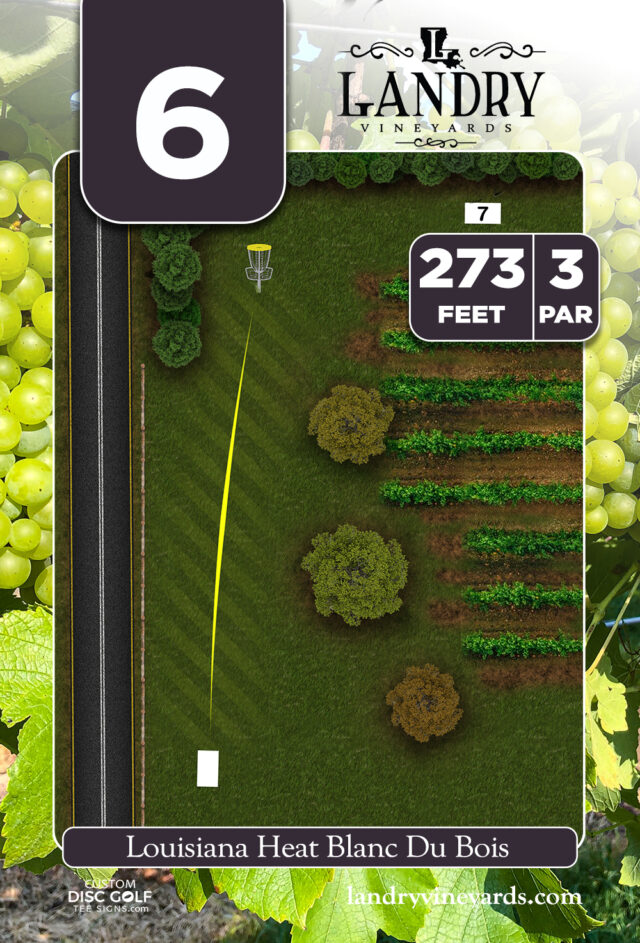
Landry Vineyards is committed to growing wine grapes that are suitable to North Louisiana growing conditions with approximately 16 acres of wine grapes in production producing 50-70 tons per year. Wine grape varieties grown at Landry Vineyards include Blanc Du Bois, Lenoir/Black Spanish, Norton, and red and white Muscadines. Landry Vineyards has 23 different wines to choose from including Dry Whites and Reds, Semi-Sweet White and Reds and Port wines. Landry Vineyards also purchases high quality wine grapes from California to produce premium hand-crafted barrel aged wines. Landry Vineyards produces more than 200,000 bottles of wine annually.
Expanding their offerings, Landry Vineyards now also features one of Louisiana’s newest disc golf courses. This 9-hole course meanders through the vineyard, providing a scenic and engaging experience for visitors. Enhancing their visitors’ experience, discs are conveniently available for sale in the tasting room, inviting both seasoned players and newcomers to the sport.
Landry Vineyards is a key player in Louisiana’s growing agritourism industry, known for its commitment to quality wine production and promoting the state’s wine culture. The addition of the disc golf course adds a unique dimension to the vineyard, making it a versatile destination for various interests.
Owners, Jeff and Libby Landry, remain grateful to many supporters throughout Louisiana and beyond, for more than 20 years of success through many adversities, all by the Grace of God!
You can book tastings and lodging at landryvineyards.com
The Mountain Manor Disc Golf Course is a 9 hole, mostly wooded course with Blue (short) & Gold (long) tee pads & multiple basket locations per hole. An 18 hole layout is made possible by using both tee pad locations. Mountain Manor DG course climbs through an old tobacco farm. Short climbs between holes 2 through 5 reward players with incredible views and a gentle decent to hole 9.
Welcome to the fascinating world of disc golf, a sport that combines the precision of golf with the casual fun of frisbee. As the popularity of disc golf continues to soar, the importance of having reliable and detailed disc golf course maps becomes increasingly crucial for players of all skill levels. In this blog post, we’ll delve into the world of disc golf course maps, exploring why they are essential and how they can transform your game.
Why Disc Golf Course Maps are a Game-Changer: Disc golf course maps are more than just simple layouts; they are the key to mastering this dynamic sport. They provide players with critical information, such as the layout of each hole, distances to the basket, and the location of various obstacles like trees, water hazards, and elevation changes. Having a map in hand means you can strategize your throws, understand the course’s challenges, and ultimately, improve your game.
Navigating the Course with Ease: One of the biggest advantages of using disc golf course maps is the ability to navigate unfamiliar courses with confidence. Whether you’re playing on a local course or exploring a new one while traveling, these maps ensure you’re never lost or unprepared. They offer an insider’s view of the course, allowing you to plan your game strategy even before you step onto the course.
Our Unique Approach to Disc Golf Course Maps: Our service stands out in the disc golf community for providing the most comprehensive and user-friendly disc golf course maps. We pride ourselves on the accuracy and detail of our maps, which are designed to cater to both beginners and seasoned pros. Our maps are constantly updated, ensuring that you have the most current information at your fingertips.
Features That Set Our Maps Apart:
- Detailed Hole-by-Hole Layouts: Each map provides an in-depth look at every hole, complete with distances and par values.
- Terrain and Obstacle Details: Understand the course’s topography and navigate around natural obstacles effectively.
- Strategic Insights: Gain valuable tips on how to approach each hole, enhancing your playing strategy.
- User-Friendly Design: Our maps are easy to read and navigate, making them accessible to players of all levels.
Conclusion: Disc golf course maps are an indispensable tool for anyone serious about improving their game. By using our detailed and accurate maps, players can enjoy a more informed and strategic approach to disc golf. Whether you’re a beginner or a seasoned pro, our maps will help you navigate each course with confidence and take your game to the next level.
Remember, the next time you’re gearing up for a round of disc golf, make sure to check out our comprehensive collection of disc golf course maps – your ultimate guide to mastering this exciting sport!
Disc golf, a popular and rapidly growing sport, relies heavily on well-designed and informative signage across its courses. These signs play a crucial role in guiding players, providing essential information, and enhancing the overall experience. Among the various types of signs used in disc golf courses, those made with Aluminum Composite Material (ACM) stand out for their durability, versatility, and weather resistance.
ACM Materials for Disc Golf Course Signs
ACM, composed of two thin aluminum sheets sandwiching a solid polyethylene (plastic) core, offers exceptional strength while being lightweight. This material is ideal for disc golf course signs due to its ability to withstand harsh outdoor conditions such as rain, wind, and sunlight.
Features of ACM Material:
- Durability: ACM is known for its durability and resilience, making it suitable for outdoor environments without succumbing to rust or corrosion.
- Weather Resistance: The composite material can withstand extreme temperatures and is highly resistant to fading, ensuring longevity in various climates.
- Versatility: ACM can be easily customized and printed on, allowing for vibrant graphics, detailed course maps, rules, and other important information to be displayed clearly.
- Low Maintenance: Its resistance to damage and discoloration reduces the need for frequent maintenance, making it a cost-effective choice in the long run.
Importance of UV Protection for Disc Golf Course Signs
UV protection is paramount when it comes to outdoor signage, especially in disc golf courses where signs are exposed to prolonged sunlight. UV-resistant coatings or laminates applied to ACM signs prevent fading, ensuring the information remains vivid and readable for an extended period.
These protective measures not only preserve the aesthetics of the signs but also maintain their functionality, ensuring players can easily navigate the course without any confusion.
Leveraging Sponsorship Placement on Disc Golf Course Signs

Disc golf course signs offer a unique advertising opportunity for local businesses and organizations. Sponsoring these signs can provide mutually beneficial opportunities:
- Cost Offset: Sponsors can help offset the expenses associated with the installation and maintenance of disc golf course signs. This can include the production costs of high-quality ACM signage.
- Enhanced Visibility: Sponsors gain exposure to a targeted audience of disc golfers who frequent the course, increasing brand visibility within the community.
- Supporting the Community: By sponsoring a disc golf course sign, businesses demonstrate their support for recreational activities and community engagement, fostering positive relationships.
For disc golf course organizers seeking sponsorships, implementing a sponsorship request form can streamline the process. By providing a straightforward and accessible method for potential sponsors to express interest, course organizers can effectively manage sponsorship inquiries and collaborations.
In conclusion, disc golf course signs made with ACM materials, coupled with UV protection, offer a durable and informative solution for course navigation. Additionally, strategic sponsorship placement not only enhances the course but also presents valuable opportunities for businesses to connect with the community while supporting a beloved sport.
Are you interested in sponsoring a disc golf course sign or exploring signage options for your course? Contact us today and let’s collaborate to enhance your disc golf experience!
Disc golf discs come in various shapes, sizes, and flight characteristics, but have you ever wondered how these discs are actually made? The process of molding a disc golf disc is a fascinating journey that involves precision, craftsmanship, and specialized techniques. Let’s take a closer look at the step-by-step process of creating these beloved flying discs.
1. Introduction to Disc Molding:
Disc golf discs are typically made from plastic polymers that are melted, molded, and cooled to achieve the desired shape and flight characteristics. The process begins with raw materials carefully selected for their durability and performance.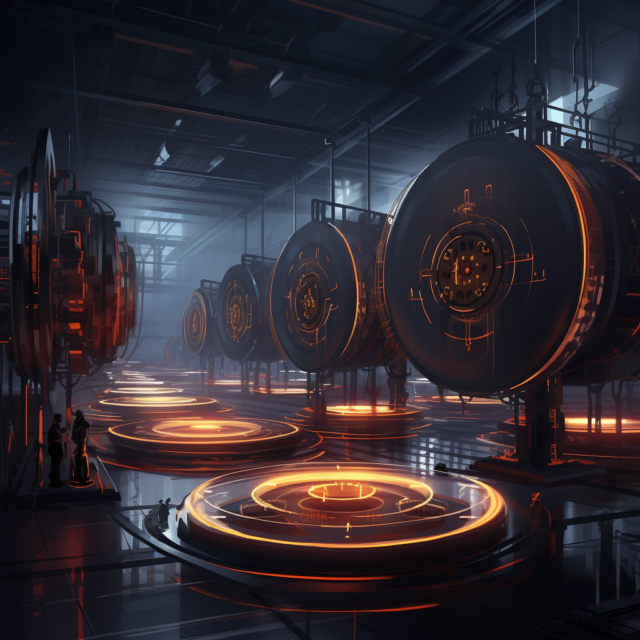
2. Raw Material Selection:
The primary raw material for disc golf discs is plastic pellets. Manufacturers often use a blend of different plastics to achieve specific properties such as flexibility, durability, grip, and weight. Some common plastics used include polyethylene, polypropylene, and blends like Z plastic or ESP plastic.
3. Heating and Injection Molding:
The selected plastic pellets are melted at high temperatures and injected into specialized molds. These molds are precision-engineered to create the unique shape, rim depth, and flight plate design of the disc. Injection molding machines apply pressure to ensure the plastic fills the mold completely and uniformly.
4. Cooling and Solidification:
Once the molten plastic fills the mold, it undergoes a rapid cooling process. Cooling is crucial for the plastic to solidify and maintain its intended shape. Controlled cooling times and temperatures are essential to prevent warping or imperfections in the final product.
5. Removal and Trimming:
After the disc has solidified, it is removed from the mold. At this stage, excess plastic or flashing around the edges is trimmed off to achieve the final, smooth shape of the disc. Any imperfections are carefully addressed during this trimming process.
6. Quality Control and Testing:
Quality control checks are conducted to ensure each disc meets specific standards. Manufacturers assess weight, dimensions, flexibility, and other performance factors to maintain consistency and quality across their product line. Some discs undergo flight testing to verify their intended flight paths.
7. Packaging and Distribution:
Once the discs pass quality control checks, they are packaged and prepared for distribution. Manufacturers label the discs with essential information such as disc name, weight, flight numbers, and often include artwork or designs.
The process of molding disc golf discs is a complex yet meticulous undertaking that combines science, technology, and craftsmanship. From the careful selection of raw materials to the precision molding and quality control measures, each step plays a vital role in creating discs that meet the diverse needs of disc golfers worldwide.
Whether you’re a casual player or a seasoned pro, understanding the intricacies of disc molding can deepen your appreciation for these essential tools of the sport.
Disc golf has surged in popularity, captivating enthusiasts of all ages and skill levels. As the sport continues to grow, the importance of well-designed and informative disc golf signs cannot be overstated. Whether you’re a beginner navigating a new course or an experienced player seeking improved navigation and aesthetics, understanding disc golf signs is key.
In this guide, we’ll explore everything you need to know about disc golf signs, from their significance and types to their design elements and how they enhance the overall disc golf experience.

Importance of Disc Golf Signs:
- Course Navigation: Disc golf signs serve as crucial navigational aids, guiding players through the course and helping them locate tees, baskets, mandatories, and hazards. An intelligently designed sign can prevent confusion and enhance the flow of play, ensuring a smoother experience for everyone.
- Information Dissemination: Beyond navigation, signs convey essential information about each hole, such as par, distance, hole layout, elevation changes, and potential obstacles. This data empowers players to strategize their throws more effectively, adding depth and challenge to the game.
Types of Disc Golf Signs:
- Tee Signs: Positioned at the beginning of each hole, tee signs provide an overview of the hole layout, distances, par, and any significant hazards or obstacles players might encounter.
- Directional Signs: Placed strategically along the course, directional signs offer guidance, indicating the direction towards the next tee or basket, ensuring a smooth transition from one hole to the next.
- Course Maps: Maps installed at key locations or at the course entrance offer an overall view of the entire disc golf course, aiding players in planning their rounds and familiarizing themselves with the layout.
Design Elements for Effective Disc Golf Signs:
- Clear and Concise Information: Use easily readable fonts and clear graphics to ensure players can quickly absorb the necessary information at a glance.
- Durability and Weather Resistance: Quality materials and weather-resistant coatings are essential to maintain sign integrity over time, despite exposure to various weather conditions.
- Aesthetics and Branding: Incorporating attractive designs, course-specific themes, or sponsor logos can enhance the overall aesthetics while also promoting the course or sponsors.
Investing in well-crafted disc golf signs isn’t just about practicality; it’s about elevating the game and fostering a greater sense of community within the disc golfing world.
Disc golfers often face an exciting challenge when encountering par four holes on the course. These longer, strategically designed holes require careful planning and execution to achieve the coveted birdie. In this guide, we’ll explore the dynamics of par four disc golf holes, emphasizing the significance of tee signs and the nuanced nature of the second shot.
Understanding Par Four Holes
Par four disc golf holes present a unique opportunity for players to showcase their skills over an extended stretch. Unlike shorter holes, where a single well-placed shot can lead to a birdie opportunity, par fours demand a more calculated approach. Typically, these holes are longer, requiring two well-executed shots to reach the basket in regulation.
Tee Signs: Your Guide to Strategy
Tee signs play a pivotal role in decoding the layout of par four holes. They provide valuable information about the hole’s length, potential obstacles, and the ideal landing zones for both the initial drive and subsequent shots. Utilizing this information effectively can significantly impact a player’s approach to the hole.
One crucial aspect highlighted by tee signs on par four holes is the strategic significance of the second shot. Unlike shorter holes where the second shot may mirror the first, par fours often demand a different approach on the subsequent play. This variability introduces an element of adaptability and strategy that tests a player’s versatility and decision-making.
Two Good Shots for Birdie
To attain a birdie on a par four, a player must masterfully navigate the hole with two exceptional shots. The first shot, typically off the tee, aims to secure an advantageous position, ideally setting up for a more manageable second shot. This initial drive sets the stage for the critical follow-up.
The second shot on a par four is where the dynamics frequently change. Factors such as wind direction, positioning after the first shot, and potential obstacles often create a different scenario compared to the previous round. Consequently, players must reassess their approach, making split-second decisions to capitalize on the best available opportunity for a successful approach shot.
Adapting to Changing Circumstances
What makes par four holes fascinating is their inherent variability. Even if a player has tackled the same hole previously, the second shot rarely mirrors the previous play. This unpredictability challenges players to think on their feet, adapt to the present circumstances, and adjust their strategy accordingly.
Ultimately, mastering par four disc golf holes is about embracing the challenge, decoding tee signs for strategic insights, and demonstrating adaptability in executing two well-calculated shots. Whether it’s adjusting to wind conditions, reevaluating the ideal landing zone, or choosing the right disc for the second shot, success on par fours demands versatility and strategic thinking.
In conclusion, the art of scoring a birdie on a par four in disc golf isn’t just about skill; it’s about understanding the nuances of the hole, utilizing tee signs for strategy, and adapting to the ever-changing dynamics of the course.
Gear up, analyze those tee signs, and let the challenge of par four disc golf holes refine your skills and strategy on the course!
Nestled in the heart of Louisiana’s natural splendor, Jimmie Davis State Park stands as a testament to the state’s rich beauty and recreational offerings. Named in honor of the two-term governor and country music legend, Jimmie Davis, this park invites visitors to immerse themselves in nature while indulging in a variety of activities catering to diverse interests and age groups.
Embracing Nature’s Bounty
Set against the backdrop of the magnificent 6,400-acre Caney Lake, Jimmie Davis State Park offers a serene escape into tranquility. Fishing enthusiasts frequent these waters, enticed by the abundance of bass, crappie, and catfish that thrive within. The park’s two convenient boat launches make it easy for visitors to set sail and explore the expansive lake, experiencing the soothing rhythm of its waters.
For those seeking a longer retreat, the lakeside cabins provide a comfortable haven, allowing guests to awaken to the tranquil beauty of the lake just beyond their doorstep.
A Haven for Recreation
Beyond the allure of Caney Lake, the park’s amenities cater to a diverse range of interests. Picnic pavilions shaded by towering trees create perfect spots for families and friends to gather, sharing meals and laughter. Playgrounds scattered throughout the park offer endless entertainment for the younger visitors, ensuring that a day at Jimmie Davis State Park is enjoyable for all.
Trails and Tranquility
Trails meandering through the park’s woodlands beckon adventurers to explore and appreciate the diverse flora and fauna. Whether seeking a leisurely stroll or an immersive hike, visitors can revel in the serene ambiance while taking in the captivating beauty of the park’s landscape.
The Unique Sporting Experience: Disc Golf
One of the standout attractions at Jimmie Davis State Park is its Par 72 disc golf course, carefully crafted to accommodate players of varying expertise. The course’s thoughtful design encompasses three separate tee pads strategically positioned to cater to different skill levels, ensuring an inclusive and enjoyable experience for all who step onto the fairways.
For those new to the sport or seeking a more relaxed round, the red tee pads offer an inviting starting point. Positioned strategically to provide shorter distances and fewer obstacles, these tee pads allow beginners to familiarize themselves with the game’s fundamentals without overwhelming challenges. The emphasis here is on comfort and enjoyment, encouraging players to develop their skills at their own pace.
Intermediate players looking for a moderately challenging game will find the white tee pads well-suited to their abilities. Positioned strategically to offer a balanced level of difficulty, these tee pads present a mix of distances and obstacles that test players’ accuracy and technique. The white tee pads strike a perfect balance between accessibility and challenge, providing an engaging experience for those seeking to refine their skills.
Designed to push the limits of seasoned disc golfers, the blue tee pads offer a formidable challenge. Positioned to provide longer distances and intricate obstacles, these tee pads demand precision, strategy, and advanced techniques. Catering to highly skilled players, the blue tee pads present a thrilling and demanding round, inviting competitive players to test their mettle against the course’s toughest layout.
As players navigate through the course, they’ll encounter diverse landscapes, including open fields and wooded areas, each presenting its own set of challenges and strategic opportunities. The breathtaking vistas serve as a backdrop to the game, enhancing the overall experience and making every throw a memorable moment.
Whether players are aiming for the beginner-friendly red tee pads, the intermediate white tee pads, or the challenging blue tee pads, Jimmie Davis State Park’s disc golf course offers an engaging and dynamic game that caters to various skill levels.
Jimmie Davis State Park’s disc golf course stands as a testament to inclusivity, providing a space where enthusiasts of all skill levels can enjoy the sport amidst the park’s serene surroundings. Whether it’s learning the ropes, honing existing skills, or embracing the challenge of the toughest layout, this course invites players to engage with the game and relish in the joy of disc golf amid Louisiana’s natural beauty.
Splash Pad Excitement for Kids
Adding to the park’s family-friendly atmosphere, Jimmie Davis State Park proudly boasts a vibrant splash pad, a delightful oasis for kids on warm Louisiana days. The splash pad provides a safe and entertaining environment where children can frolic and cool off, creating joyful memories in the heart of nature.
Embrace Nature’s Beauty
Jimmie Davis State Park in Louisiana is more than just a natural retreat; it’s a sanctuary where families, outdoor enthusiasts, and individuals seeking tranquility find solace in the embrace of nature. With its stunning setting around Caney Lake, an array of recreational activities, lakeside cabins, a splash pad for kids, and the allure of its disc golf course, this park encapsulates the essence of Louisiana’s outdoor allure.
Whether casting a line into the lake’s waters, embarking on scenic hikes, enjoying a game of disc golf, or delighting in the splash pad’s excitement, Jimmie Davis State Park invites visitors to immerse themselves in the unparalleled beauty of nature and create lasting memories in this captivating Louisiana destination.
The allure of disc golf extends beyond its competitive spirit to the captivating physics governing the flight paths of discs. Envision the complexities of discs in motion, the leftward turn for right-handed throwers, and the nuanced impact of wind resistance on their trajectory. Delve deeper into this fascinating realm where aerodynamics, angular momentum, and wind dynamics converge.
The Physics of Disc Flight: An In-depth Exploration
- Aerodynamic Dynamics of Discs: Discs are meticulously crafted aerodynamic entities, featuring an asymmetrical design akin to an “aerofoil.” This unique shape manipulates air pressure disparities between the upper and lower surfaces, generating lift to sustain flight.
- Angular Momentum and Gyroscopic Stability: Upon release, discs spin rapidly around their axis, creating angular momentum. This gyroscopic stability acts as a stabilizing force, preserving the disc’s orientation mid-flight and thwarting undesired deviations.
- Release Angle’s Influence: The crucial factor influencing a disc’s flight path is the release angle. For right-handed backhand throws, a specific release angle induces a leftward turn, initiating a graceful curve before a controlled fade back to the right.

Deciphering Wind Resistance and Its Impact
- Drag Forces on Discs: As discs traverse through the air, they encounter drag—a resistance opposing their forward motion. The leading edge of the disc bears the brunt of this drag force, dictating its speed and altering its flight trajectory.
- Wind’s Alteration of Trajectory: Headwinds present a formidable challenge, intensifying drag on the disc’s leading edge. This force decelerates the disc and induces an earlier fade or diminished turn. Crosswinds, meanwhile, can forcibly shift the disc off its intended path, posing accuracy challenges mid-flight.
Interplay of Disc Design, Wind, and Flight Response
- Disc Stability Dynamics: Discs possess varying stability levels, influencing their behavior in wind conditions. Overstable discs exhibit greater resistance to turning, rendering them more adept at countering headwinds. Conversely, understable discs might amplify their turn under the influence of increased drag on their leading edge.
- Skillful Adaptations and Mastery: A seasoned player’s arsenal involves adaptive techniques to mitigate wind resistance. Fine-tuning release angles, selecting discs tailored to specific wind patterns, and modulating spin rates are tactical maneuvers to harness control amid diverse wind scenarios.
Disc golf’s allure lies not just in its strategic gameplay, but in the intricate dance between physics and flight dynamics. From the calculated leftward turn for right-handed throwers to the intricate influence of wind resistance on trajectory, every flight is a ballet of aerodynamics and force interplay.
Mastery of these scientific intricacies and the artful manipulation of discs through varied wind conditions can elevate a player’s finesse and precision. Whether observing the mesmerizing arcs of discs or adeptly adapting throws to counter wind resistance, players unlock a realm of heightened accuracy and control within the exhilarating world of disc golf.
In recent years, the popularity of disc golf has soared, captivating enthusiasts of all ages and fitness levels. Beyond its recreational appeal and community spirit, this sport offers a plethora of health benefits, notably contributing to a healthier heart and overall fitness. Let’s delve into how disc golf can elevate cardiovascular health while fostering an enjoyable and active lifestyle.
The Cardiovascular Workout
Disc golf is a dynamic sport that involves walking, jogging, and occasionally sprinting across varied terrain. The nature of traversing the course—often through hills, woods, and diverse landscapes—provides an excellent cardiovascular workout. Each throw and subsequent walk to the disc engages the body, steadily increasing heart rate and improving endurance.

Aerobic Exercise and Heart Health
Engaging in disc golf encourages aerobic exercise—a cornerstone of heart health. Aerobic activities, like those in disc golf, help to strengthen the heart muscle, enhance circulation, and improve the body’s ability to utilize oxygen. Regular participation in this sport can contribute to lowering blood pressure, reducing the risk of heart disease, and improving overall cardiovascular fitness.
Stress Reduction and Mental Well-being
Beyond the physical benefits, disc golf offers mental health advantages. The outdoor setting, fresh air, and engaging gameplay promote stress reduction and relaxation. Lower stress levels
are associated with improved heart health, as chronic stress can negatively impact cardiovascular function.
Low-Impact, Joint-Friendly Exercise
One of the key advantages of disc golf is its low-impact nature. Unlike high-impact sports, disc golf places minimal stress on joints while still providing an effective workout. This makes it an accessible activity for individuals of various fitness levels and ages, allowing them to engage in regular physical activity without risking joint injuries or strains.
Social Engagement and Community Bonding
Disc golf isn’t just a solo sport—it’s a communal experience. Playing rounds with friends, family, or fellow enthusiasts fosters social connections, which positively impact mental and emotional well-being. The camaraderie and shared experiences add to the overall enjoyment and motivation to stay active.
Tips for Maximizing Health Benefits
- Stay Hydrated: Remember to drink plenty of water throughout your rounds to stay hydrated, especially during warmer weather.
- Warm-Up and Stretch: Prioritize a proper warm-up and stretching routine to prepare your body and prevent injuries.
- Maintain Good Form: Focus on proper throwing techniques to minimize strain and maximize efficiency.
- Listen to Your Body: Pay attention to your body’s cues. Take breaks when needed and avoid overexertion.
In conclusion, disc golf offers an exciting way to enhance heart health, overall fitness, and well-being. With its combination of physical activity, outdoor enjoyment, and social interaction, it presents an appealing avenue for individuals seeking to improve their cardiovascular health while having fun. So grab your discs, hit the course, and embark on a journey towards a healthier heart and a more active lifestyle through the joys of disc golf.
Tee signs in disc golf aren’t just markers; they’re the initial guides that pave the way for an exhilarating round. Crafting an effective tee sign involves a blend of essential elements that go beyond mere information provision. Let’s uncover the best practices that transform ordinary tee signs into indispensable course companions, enhancing the player experience and guiding them through the intricacies of each hole.
Visibility Is Key:
The first rule of an effective tee sign is visibility. Ensure that the sign is easily spotted from the tee pad, even at a distance. Opt for clear and bold fonts with high contrast against the background to guarantee readability in various lighting conditions.
Durability Against Elements:
Tee signs endure the brunt of outdoor elements. Select materials known for their durability, capable of withstanding rain, sun, wind, and other environmental factors. Metal, high-grade plastics, or weather-resistant composites often serve well in maintaining longevity.
Weather Resistance for Longevity:
Shielding the vital information from weather-induced wear is imperative. Laminated graphics, protective coatings, or weatherproof materials safeguard the signs against fading, warping, or damage caused by prolonged exposure to the elements.
Information Clarity and Conciseness:
Clarity reigns supreme. Ensure that the information presented on tee signs is clear, concise, and relevant. Include hole number, distance to the basket, par, and any notable obstacles or hazards. Avoid cluttering the sign with excessive details that might overwhelm or confuse players.
User-Friendly Design:
A well-designed tee sign is intuitive. Organize information in a logical sequence that aids players in swiftly interpreting the hole layout. Utilize graphics, arrows, or icons to illustrate fairways, basket placements, and the intended flight path, aiding players in making informed shot decisions.
Maintenance and Upkeep:
Regular maintenance is crucial for preserving tee signs. Periodic inspections, cleaning, and repairs ensure that the signs remain in top-notch condition. Establishing a maintenance schedule helps in addressing any wear or damage promptly.
Engaging and Informative:
Enhance the player experience by making tee signs engaging and informative. Consider incorporating interesting facts about the course, historical anecdotes, or local flora and fauna. Engaging content fosters a deeper connection between players and the course.
Community Involvement:
Involve the disc golf community in the tee sign creation process. Seek feedback from players to understand their preferences and requirements. Collaborating with local artists or enthusiasts can infuse creativity and a sense of community ownership into the signs.
Mastering tee sign excellence involves a careful blend of functionality, durability, and user engagement. By adhering to these best practices, disc golf courses can elevate the tee sign experience, guiding players through an immersive and enjoyable round.
Tee signs aren’t just markers; they’re storytellers that unveil the narrative of each hole, setting the stage for thrilling disc golf adventures.
In recent years, a sport that has been gaining widespread popularity among families is disc golf. Often hailed as the perfect activity for people of all ages, disc golf offers an incredible blend of outdoor recreation, physical exercise, and family bonding. What makes disc golf truly unique is its ability to bring generations together while immersing them in the serenity of nature.
Disc Golf: A Game for Every Generation
- Accessible for All Ages: One of the most appealing aspects of disc golf is its inclusivity. From grandparents to grandchildren, everyone can participate regardless of age or skill level. Courses typically offer various tee positions, allowing players of different ages and abilities to enjoy the game at their own pace. This inclusiveness fosters an environment where family members can compete, have fun, and cheer each other on.
- Simplicity and Ease: Unlike traditional golf, disc golf is relatively easy to learn. The basic rules involve throwing a disc from a tee pad into a metal basket, with the aim of completing each hole in as few throws as possible. Its simplicity makes it accessible for children and older family members, fostering a sense of camaraderie and shared experiences.
- Promotes Healthy Competition: While disc golf is competitive, it emphasizes friendly competition and sportsmanship over intense rivalry. Families can enjoy friendly matches while instilling essential values of teamwork, patience, and respect for others.

Embracing Nature Through Disc Golf
- Outdoor Adventure: Disc golf courses are typically set in scenic natural environments, providing an opportunity for families to immerse themselves in nature. Walking through lush greenery, navigating diverse terrain, and enjoying fresh air contribute to a holistic outdoor experience.
- Educational Opportunities: Nature-rich disc golf courses often offer opportunities for learning and exploration. Families can observe wildlife, identify various plant species, and learn about environmental conservation while enjoying a game together. It serves as a hands-on educational experience that engages both young and old.
- Physical and Mental Well-being: Engaging in outdoor activities like disc golf promotes physical fitness and mental well-being. The game involves walking, throwing, and strategizing, offering an enjoyable way for families to stay active while having fun.
Disc golf stands out as a sport that caters to the diverse needs and preferences of families. Its ability to unite multiple generations and provide a platform for enjoying nature makes it an ideal choice for family outings. Beyond being a recreational activity, disc golf fosters bonds, creates lasting memories, and instills values that transcend the game itself. As families seek meaningful ways to spend quality time together, disc golf continues to emerge as the perfect amalgamation of sport, nature, and family togetherness.
So, why not grab a few discs, gather the family, and head out to a local disc golf course? Experience the joy of competition, the serenity of nature, and the joy of spending quality time together—all in one unforgettable game.
Remember, in the world of disc golf, the real victory lies in the shared moments and cherished memories with your loved ones.
In the world of disc golf, tee signs stand tall as essential guides, revealing the mysteries and challenges of each hole. Beyond their functional purpose, tee signs are canvases that encapsulate crucial information and artistic flair, revolutionizing the way players approach the game. Let’s unravel the diverse design elements that make these markers not just informative but also visually captivating.

Materials Matter:
Tee signs come in a myriad of materials, each with its own advantages. Wood, metal, plastic, and composite materials are commonly used due to their durability and weather resistance. Metal signs offer longevity, while wooden signs evoke a rustic charm. The choice of material often depends on the course’s environment and maintenance requirements.
Size Variations and Visibility:
From compact signs to larger-than-life installations, tee signs vary in size. While some courses opt for smaller, discreet signs, others prefer substantial displays visible from a distance. The visibility of tee signs is a crucial consideration, ensuring that players can easily locate and read them from the tee pad.
Course Maps and Graphics:
One of the most compelling design elements of tee signs is the inclusion of detailed course maps. These maps provide a bird’s-eye view of the hole, showcasing fairway routes, potential hazards, and basket placements. Graphic representations of fairways and basket placements aid players in strategizing their throws, fostering a deeper understanding of the hole layout.
Additional Information:
Aside from the basic hole number, distance, and par, tee signs often incorporate additional information. This might include elevation changes, suggested shot types, or unique challenges specific to the hole. Descriptive text or icons provide valuable insights that aid players in making informed decisions before they tee off.
Artistic Expression and Customization:
Tee signs aren’t just utilitarian; they’re also platforms for artistic expression. Some courses feature custom-designed signs, showcasing local artwork, course logos, or thematic elements that capture the essence of the surroundings. This personal touch adds character and uniqueness to each tee sign, leaving a lasting impression on players.
Innovative Technology Integration:
Modern tee signs embrace technology to enhance the player experience. Some incorporate QR codes linking to detailed online course maps or augmented reality features that offer interactive hole previews. These innovations bridge the gap between physical markers and digital resources, providing players with comprehensive information.
The design elements of tee signs in disc golf encompass a fusion of functionality and creativity. From material choices to innovative technological integrations, these markers serve as informative guides while also captivating players with their visual appeal. Each tee sign embodies the course’s spirit, offering a glimpse into the challenges and beauty that lie ahead.
As disc golf courses continue to evolve, so too will the design elements of tee signs, shaping the game and captivating players with every throw.
Stay tuned for more explorations into the world of disc golf design!
Disc golf, a blend of precision, strategy, and enjoyment, thrives not just on the challenges of the course but also on the guidance it offers through signage. As players venture across varying terrains and landscapes, clear and effective signage becomes a crucial companion. In this blog post, we delve into the essential elements that contribute to making course signage truly impactful and enhancing the disc golf experience for players of all levels.

Signage effectiveness hinges on its ability to swiftly communicate vital information. Clarity is key – concise text and well-defined graphics ensure players glean necessary details at a glance. From the hole number to the distance, par, and a comprehensible course map, each piece of information should be presented succinctly. For instance, a clear depiction of the hole layout enables players to strategize their throws, anticipating obstacles and planning their approach.
Visual aids within signage are the unsung heroes, bridging the gap between words and understanding. An effective sign does not merely convey information; it also guides effortlessly. Employing colors for differentiation, intuitive icons or symbols for hazards, and directional arrows for seamless navigation enhances overall comprehension. A well-designed sign acts as a visual roadmap, guiding players through the course with ease.
Inclusivity is paramount in disc golf. Signage must be accessible to all players, irrespective of physical abilities. Placement plays a pivotal role here – signage should be positioned at appropriate heights and locations to cater to diverse needs. Ensuring readability from various angles and distances is crucial. Additionally, catering to players with disabilities, such as visually impaired individuals, requires thoughtful design and possibly tactile elements to aid comprehension through touch.
Let’s take a closer look at some prime examples of effective disc golf course signage:
- Clear Typography: Signs employing bold, legible fonts for easy readability.
- Strategically Placed Maps: Course maps are placed at tee pads to aid pre-shot planning.
- Color-coded Icons: Symbols representing hazards or basket positions using distinct colors for quick identification.
- Braille Inclusion: Signs incorporating Braille for visually impaired players, promoting inclusivity.
The efficacy of disc golf course signage is not just about relaying information; it’s about enhancing the entire playing experience. By prioritizing clear, concise information, incorporating visual aids, and ensuring accessibility, course signage becomes a valuable ally to players, guiding them through each hole and elevating their game.
Remember, behind every successful throw lies the guidance of effective signage – a silent but essential partner in the game of disc golf.
In the world of disc golf, the desire for improvement is a constant driving force. While playing rounds on familiar courses can be enjoyable, the key to unlocking your full potential lies in the deliberate act of practice. In this post, we’ll explore why dedicated practice sessions are superior to constant gameplay, and how challenging courses can be the crucible where true disc golf mastery is forged.
The Power of Practice:

Imagine disc golf as a skill-based craft, much like mastering a musical instrument or perfecting a dance routine. While playing regularly certainly builds experience, true skill
refinement happens during practice. Here’s why:
- Focused Skill Development: Practice allows you to isolate and focus on specific aspects of your game, be it putting, driving, or mid-range shots. It’s an intentional effort to fine-tune your technique.
- Repetition and Muscle Memory: The more you repeat a specific throw or technique, the more ingrained it becomes in your muscle memory. Consistent practice helps build the muscle memory needed for consistent and reliable performance.
- Targeted Improvement: Identify weaknesses in your game and design practice routines to address them. Whether it’s increasing accuracy or enhancing control, targeted practice sessions yield noticeable improvements.
Quality Over Quantity:
While playing rounds can be a thrilling way to enjoy the sport, the focus should be on the quality of your play, not just the quantity. Deliberate practice involves thoughtful engagement with each throw, analyzing the mechanics, and seeking areas for improvement.
The Challenge of Difficult Courses:
There’s a saying that goes, “Smooth seas do not make skillful sailors.” Similarly, easy and familiar courses may not foster the growth needed to become an elite disc golfer. Playing on challenging courses offers several benefits:
- Adaptability: Difficult courses force you to adapt your playstyle, learning to navigate various obstacles and terrains. This adaptability translates into a more versatile skill set.
- Mental Toughness: Overcoming challenges on difficult courses builds mental resilience. Facing obstacles and making strategic decisions under pressure are invaluable skills in competitive disc golf.
- Statistical Insights:
According to a study conducted by the Disc Golf Pro Tour, players who regularly practiced specific elements of their game showed a more consistent improvement in performance compared to those who primarily focused on playing rounds. The study also indicated that players who took on more challenging courses saw a steeper learning curve and improvement in their overall game.
Conclusion:
In the quest to become a master of the disc golf course, deliberate practice and a willingness to tackle challenges head-on are your greatest allies. While playing rounds is undeniably enjoyable, it’s the intentional act of practice and the embrace of challenging courses that will propel you to new heights in your disc golf journey. So, step onto the practice field, face the challenges, and watch your disc golf skills soar to unparalleled levels of excellence. The path to mastery is paved with purposeful throws and conquered obstacles.













